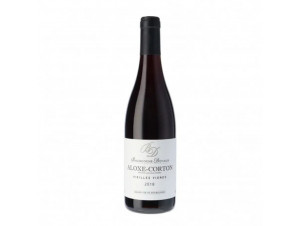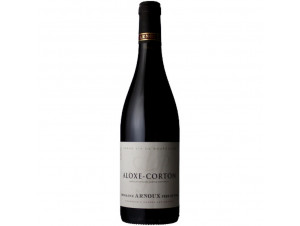You have no items in your shopping cart.
Wine Aloxe-Corton
-
Top Selling
-
Top Selling-20%
-
Top Selling-31%
- -30%
Halfway down the slope are the 14 climats of Aloxe-Corton classified as premiers crus, at the bottom of the slope the village appellation of Aloxe-Corton is represented. The white or red wines of this appellation are produced in three communes which are Aloxe-Corton, Ladoix-Serrigny and Pernand-Vergelesses.
The history of the Aloxe-Corton appellation dates back to Charlemagne
The first traces of vines attested in the Aloxe-Corton appellation date back to the early 6th century and correspond to the development of abbeys in the region. In 775, the Emperor Charlemagne is said to have donated vines to the Saint-Andoche Abbey in Saulieu. This imperial mark can still be seen today, particularly with the name of the climate "Le Charlemagne". Legend has it that Charlemagne was seduced by the great red wines of the Corton mountain. While tasting this prestigious wine, he stained his beard with the red wine. In anger he decided to have the feet ofPinot Noir ripped out to plant Chardonnay.This legend gave birth to the great white wines that are Charlemagne and Corton-Charlemagne.
Between the 7th and 11th centuries, the Chapter of the Cathedral of Autun strongly influenced the Vinoble Beaune and in particular in Aloxe-Corton with the possession of the climates now called "Clos du Chapitre" and "Corton Clos des Meix". In the 12th century, the abbey of Cîteaux owned an estate on these hillsides, including the climat "Les Vercots". In the 15th century, the so-called "Beaune" wines were marketed throughout Europe thanks to their long shelf life, which allowed them to travel. Trade developed and it was in the 18th century that the wine merchants and breeders gave a real boost to the distribution of Beaune wines in Europe.
The reputation acquired by the wines and in particular those of Corton were to be synonymous with quality which was to push in 1862 the commune of Aloxe to add to its name that of Corton.
The end of the 19th century was marked by two major plagues, mildew and phylloxera.
The marl and limestone soils give the wines of Aloxe-Corton an inimitable taste
The Aloxe-Corton appellation covers 120 ha, 37 ha of which are Premier Cru. Corton covers 160 ha while Corton-Charlemagne covers 71 ha of which 62 ha are Charlemagne. This appellation is located in the North-East of Beaune. The mountain of Corton separates the chalky plateaus of the Hautes Côtes de Beaune and the Bresse plain. In this appellation, the Pinot Noir dominates. The production of great white wines is rare there for the village appellation and the premiers crus. It should be noted that Corton is the only grand cru to produce red wines on the Côte de Beaune.
This appellation culminates between 230 and 350 m of altitude. The wood which culminates at 385 metres above sea level is not without impact on the vineyards of this appellation. Indeed, the chalky soils of the wood will be broken down into small platelets by the forces exerted by the roots of the trees and the phenomenon of erosion. These platelets will slide with time and come to mix with the marl present in the form of "Chailles" dating from the Upper Jurassic. It is from these marl limestone soils that the great white wines Corton-Charlemagne and Charlemagne are produced. On the lower slopes, the limestone substratum dates from the Middle Jurassic. It is covered by a layer of mostly clayey colluvium which gives shallow, draining soils more favourable to the expression of Pinot noir.
What does one recognise an Aloxe-Corton?
The Aloxe-Corton appellation is a very diverse appellation. Going from the east to the west of the mountain with various soils and different winemakers. Each wine is unique! However they are allwines for laying down or great laying down depending on the vintage.
For the reds of Aloxe-Corton, the robe is dark with a ruby to garnet hue. The nose presents notes of small red and black fruits which with time will evolve towards jammy and fruit in brandy notes. The tertiary aromas will develop on notes of undergrowth, mushroom, leather, the fruity notes will still be present. The palate is elegant, fruity, racy, powerful and structured. The tannins are harmonious.
The white wines of the Aloxe-Corton appellation are very rare. Their colour is pale yellow with green reflections. They present mineral aromas with notes of fresh fruit and a little spicy touch. With time the aroma of hazelnut will subtly complete the aromas of this wine. The palate is supple, generous and delicate.
How to enjoy an Aloxe-Corton
.Red wines that have a generous, opulent and powerful side go well with grilled or sauced red meats and roast poultry. They go beautifully with soft or washed-rind cheeses such as Epoisses, Ami Chambertin and many others.
White wines pair with raw or baked fish, seafood, grilled poultry or well with cheeses such as camembert or gruyere.
What are the great vintages of the Aloxe-Corton appellation?
Whatever the vintage, the winegrowers agree to produce the best wine that the weather allows. It is this weather and this terroir that give the wines their typicality and that make each year's product different. For the red or white wines of Aloxe-Corton the exceptional vintages are numerous due to the exposure of its climates. To name but a few we have 1928, 1929, 1937, 1945, 1949, 1953, 1959, 1966, 1971, 1978.
Nearer to us the millesimes 2002, 2005 and 2009 are exceptional vintages which have allowed us to obtain wines of great quality in excellent climatic conditions for the vine.
The emblematic domains of the Aloxe-Corton appellation
Jean Claude Boisset House:
Jean Claude Boisset is at the head of some thirty brands. The eponymous brand is located in Nuits-Saint-Georges in the former Ursuline convent. Taken over by Jean-Claude Boisset's children, this estate is constantly striving to improve the quality of its wines. Grégory Patriart is the current winemaker of the house. He vinifies 72 red wines including an Aloxe-Corton and an Aloxe-Corton 1er cru always with respect for the grapes and the wine.Louis Latour House:
The house of Louis Latour was established in Aloxe-Corton in 1749. This independent family house is now run by the 11th generation. It is today the largest Burgundian domain. Respectful of the environment it practices a reasoned agriculture on the 48 ha it owns. Extended in France this house is established in Ardeche, Beaujolais, Burgundy, Chablisien and Var.Blagny
Burgundy Rosé
Burgundy-Côte-Saint-Jacques
Burgundy-Côtes-du-Couchois
Burgundy-Coulanges-la-Vineuse
Burgundy-Épineuil
Burgundy-Grand-Ordinaire
Burgundy-Hautes-Côtes-de-Beaune
Burgundy-Hautes-Côtes-de-Nuits
Burgundy-Vézelay
Crème de fruits
Criots-Bâtard-Montrachet
La Tache
Liqueur
Mâcon Supérieur
Mâcon-Bray
Mâcon-Chaintré
Mâcon-Cruzille
Mâcon-Vergisson
Mazoyères-Chambertin
Pouilly-Loché
Romanée-Saint-Vivant
Ruchottes-Chambertin
Vin de Pays de Sainte-Marie-la-Blanche
Vin de Pays des Coteaux de l'Auxois






























 TWIL - Achat de Vin
TWIL - Achat de Vin


